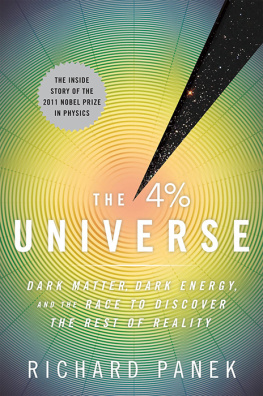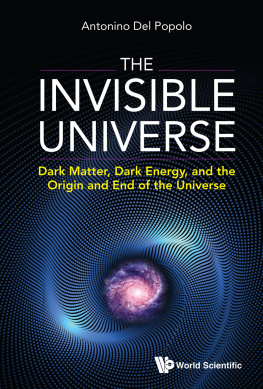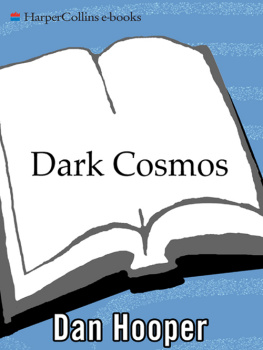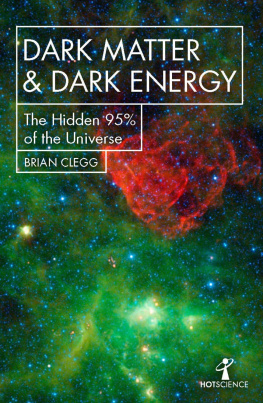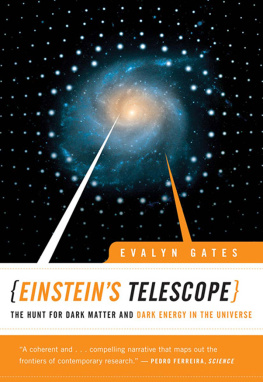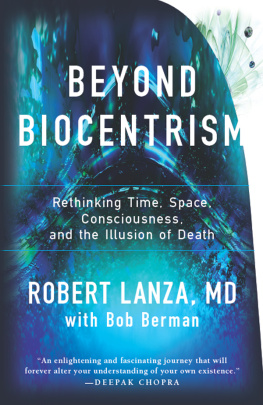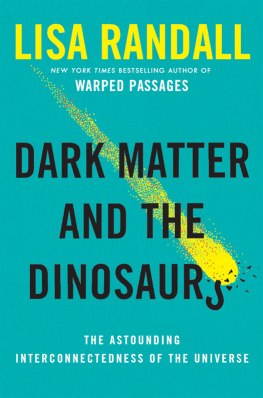The 4 Percent Universe
Dark Matter, Dark Energy, and The Race to Discover the Rest of Reality
Richard Panek
Table of Contents
HOUGHTON MIFFLIN HARCOURT
Boston New York
2011
Copyright 2011 by Richard Panek
All rights reserved
For information about permission to reproduce selections from this book, write to
Permissions, Houghton Mifflin Harcourt Publishing Company, 215 Park Avenue South,
New York, New York 10003.
www.hmhbooks.com
Library of Congress Cataloging-in-Publication Data
Panek, Richard.
The four-percent universe : dark matter, dark energy, and the race to discover the rest of
reality / Richard Panek.
p. cm.
Includes bibliographical references and index.
ISBN 978-0-618-98244-8
1. Cosmology. 2. Physics. 3. Astrophysics. I. Title.
QB981.P257 2010
523.1dc22 2010025838
Book design by Lisa Diercks
This book is typeset in Bulmer, Hydra Text, and Belizio.
Printed in the United States of America
DOC 10 9 8 7 6 5 4 3 2 1
Some passages in this book appeared, usually in different form, in Discover, the New York
Times Magazine, Sky & Telescope, and Smithsonian.
Portions of chapter 11 are based on work supported by the National Science Foundation
under Grant No. 0739893. Any opinions, findings, and conclusions or recommendations
expressed in this material are those of the author and do not necessarily reflect the views of
the National Science Foundation.
For Meg, with love
"I know," said Nick.
"You don't know," said his father. Ernest Hemingway
Contents
Acknowledgments
Prologue
PART I. MORE THAN MEETS THE EYE
1. Let There Be Light
2. What's Out There
3. Choosing Halos
PART II. LO AND BEHOLD
4. Getting in the Game
5. Staying in the Game
6. The Game
PART III. THE FACE OF THE DEEP
7. The Flat Universe Society
8. Hello, Lambda
9. The Tooth Fairy Twice
PART IV. LESS THAN MEETS THE EYE
10. The Curse of the Bambino
11. The Thing
12. Must Come Down
Epilogue
Notes
Works Cited
Index
Acknowledgments
T HE AUTHOR EXPRESSES deep appreciation to Amanda Cook for her extraordinary editorial guidance as well as her genuine passion for the dark side of the universe; Henry Dunow, who, with his usual wisdom, made the match of editor and author; Katya Rice for her expert eye; Katherine Bouton for taking a chance on science and assigning an article on this subject; the John Simon Guggenheim Memorial Foundation, the National Science Foundation's Antarctic Artists and Writers Program, and the New York Foundation for the Arts for their generous and essential support; and Gabriel and Charlie (who claim to know what dark matter and dark energy are but refuse to tell their father, who loves them anyway).
Prologue
T HE TIME HAD come to look inside the box. On November 5, 2009, scientists at sixteen institutions around the world took their seats before their computer screens and waited for the show to begin: two software programs being run by two graduate studentsone at the University of Minnesota, the other at the California Institute of Technologysimultaneously. For fifteen minutes the two scripts would sort through data that had been collecting far underground in a long-abandoned iron mine in northern Minnesota. Over the past year, thirty ultrasensitive detectorsdeep-freeze cavities the size of refrigerators, shielded from stray cosmic rays by half a mile of bedrock and snug blankets of lead, their interiors cooled almost to absolute zero, each interior harboring a heart of germanium atomshad been looking for a particular piece of the universe. The data from that search had sped from the detectors to offsite computers, where, following the protocol of a blind analysis, it remained in a "box," out of sight. Just after 9 A.M. Central Time, the "unblinding party" began.
Jodi Cooley watched on the screen in her office at Southern Methodist University. As the coordinator of data analysis for the experiment, she had made sure that researchers wrote the two scripts separately using two independent approaches, so as to further ensure against bias. She had also arranged for all the collaborators on the projectphysicists at Stanford, Berkeley, Brown; in Florida, Texas, Ohio, Switzerlandto be sitting at their computers at the same time. Together they would watch the evidence as it popped up on their screens, one plot per detector, two versions of each plot.
After a few moments, plots began appearing. Nothing. Nothing. Nothing.
Then, three or four minutes into the run, a detection appearedon the same plots in both programs. A dot on a graph. A dot within a narrow, desirable band. A band where all the other dots weren't falling.
A few minutes later another pair of dots on another pair of plots appeared within the same narrow band.
And a few minutes later the programs had run their course. That was it, then. Two detections.
"Wow," Cooley thought.
Wow, as in: They had actually seen something, when they had expected to get the same result as the previous peek inside a "box" of different data nearly two years earliernothing.
Wow, as in: If you're going to get detections, two is a frustrating numberstatistically tantalizing but not sufficient to claim a discovery.
But mostly Wow, as in: They might have gotten the first glimpse of dark mattera piece of our universe that until recently we hadn't even known to look for, because until recently we hadn't realized that our universe was almost entirely missing.
It wouldn't be the first time that the vast majority of the universe turned out to be hidden to us. In 1610 Galileo announced to the world that by observing the heavens through a new instrumentwhat we would call a telescopehe had discovered that the universe consists of more than meets the eye. The five hundred copies of the pamphlet announcing his results sold out immediately; when a package containing a copy arrived in Florence, a crowd quickly gathered around the recipient and demanded to hear every word. For as long as members of our species had been lying on our backs, looking up at the night sky, we had assumed that what we saw was all there was. But then Galileo found mountains on the Moon, satellites of Jupiter, hundreds of stars. Suddenly we had a new universe to explore, one to which astronomers would add, over the next four centuries, new moons around other planets, new planets around our Sun, hundreds of planets around other stars, a hundred billion stars in our galaxy, hundreds of billions of galaxies beyond our own.
By the first decade of the twenty-first century, however, astronomers had concluded that even this extravagant census of the universe might be as out-of-date as the five-planet cosmos that Galileo inherited from the ancients. The new universe consists of only a minuscule fraction of what we had always assumed it didthe material that makes up you and me and my laptop and all those moons and planets and stars and galaxies. The restthe overwhelming majority of the universeis ... who knows?
"Dark," cosmologists call it, in what could go down in history as the ultimate semantic surrender. This is not "dark" as in distant or invisible. This is not "dark" as in black holes or deep space. This is "dark" as in unknown for now, and possibly forever: 23 percent something mysterious that they call dark matter, 73 percent something even more mysterious that they call dark energy. Which leaves only 4 percent the stuff of us. As one theorist likes to say at public lectures, "We're just a bit of pollution." Get rid of us and of everything else we've ever thought of as the universe, and very little would change. "We're completely irrelevant," he adds, cheerfully.
All well and good. Astronomy is full of homo sapiens-humbling insights. But these lessons in insignificance had always been at least somewhat ameliorated by a deeper understanding of the universe. The more we could observe, the more we would know. But what about the less we could observe? What happens to our understanding of the universe then? What currently unimaginable repercussions would this limitation, and our ability to overcome it or not, have for our laws of physics and our philosophyour twin frames of reference for our relationship to the universe?
Next page
